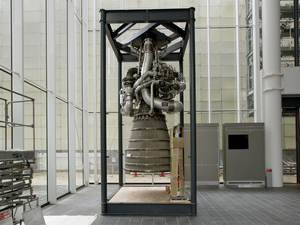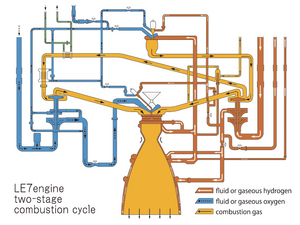Nagoya City Science Museum
TOP > Exhibition Guide > Floor Map> LE-7 Engine
LE-7 Engine



Purpose of Exhibition
The engine exhibited in the entrance hall is an LE-7 used as the main engine of an H-II rocket, the first rocket built solely with Japan's own technology. This LE-7 engine is a product of the dreams, wisdom and efforts engineers poured unstintingly to overcome the hardest part of H-II rocket development.
The LE-7 is a very efficient engine, burning liquid hydrogen and liquid oxygen as fuel. The LE-7A engine was improved based on the technology accumulated with the LE-7 engine and is used for mainly the H-IIA rocket in Japan now.
Additional Knowledge
[Two-stage Combustion System]
To launch a large rocket, it is necessary to burn a large quantity of fuel efficiently. To achieve this, this engine (LE-7) has adopted a two-stage combustion system. Part of the fuel is burnt first to turn a turbine to feed fuel from the tank to the engine. This system allows the engine to burn fuel without loss and obtains a large thrust force. The development of the system, however, involved many technical difficulties before it was perfected. For example, when liquid hydrogen fuel is burnt, temperature rises rapidly from minus 253 degrees to 3000 degrees. Burnt fuel generates great pressure. The engine must endure a very drastic change of temperature and large pressure. Solving these problems one by one, using Japanese technology, has perfected one of the highest performing engines in the world with 100% homemade technology.
[H-II Rocket]
The H-II rocket was developed to fulfill needs for launching a large satellite at a low cost, while ensuring a high reliability level. Japanese rockets developed prior to it used foreign technologies in some part, which imposed various restrictions on the application of these rockets. The H-II rocket, however, was developed with 100% homemade technology, so it has given Japan a free hand to promote space development programs of its own. It can launch a satellite weighing up to 2 tons to a geo-stationary orbit of approx. 36,000 km altitude, or up to 10 tons to an orbit of lower altitude. In other words, it can launch a large motor-bus into space. The H-II rocket measures 50 m tall and weighs 260 tons. The engine exhibited (LE7) is the main engine used for it. Together with the fixed fuel rockets that flank the rocket, the main engine lifts up an H-II rocket from the ground to space at once.
[The Launch of the First Rocket]
The first H-II rocket was launched from the Yoshinobu launch pad in the Tanegashima Space Center on February 4, 1994. Orbital Re-entry Experiment and Vehicle Evaluation Payload (Cargo) were also launched. A total of 8 rockets were produced until the eighth rocket was launched in November 1999.
[Contribution of the H-II Rocket]
Because the LE-7 engine stopped early after H-II8 launch, destruction was ordered and carried out. The National Space Development Agency of Japan collected LE-7 engine with the cooperation of the Japan Marine Science and Technology Center from the bottom of the sea at about 3,000 meters water depth off Ogasawara to investigate the cause of this accident. A policy of ensuring reliability was considered by investigation, analysis, and examination. It was taken over for new H-IIA rockets. H-IIA's basic form was followed by the H-II, but major design changes were performed, with the aim to significantly reduce costs (from 19 billion yen to 8.5 billion yen) and according to the availability of upsizing the satellite. The first H-IIA was launched in August, 2001 and it is continues to operate. The LE-7A engine, which is an improved LE-7 engine, was adopted in the first stage of the H-IIA rocket.
Article by Masao Suzuki, curator
